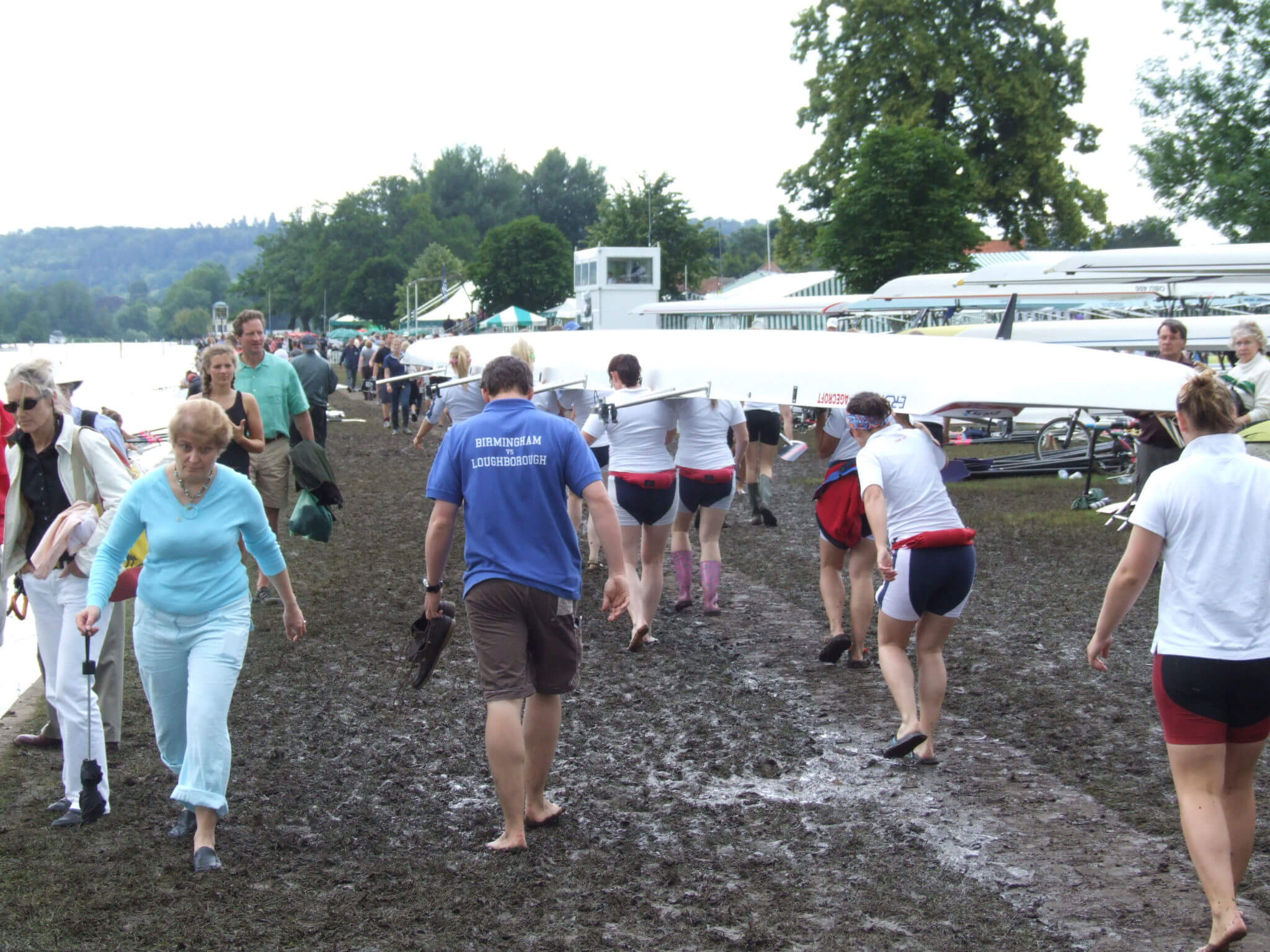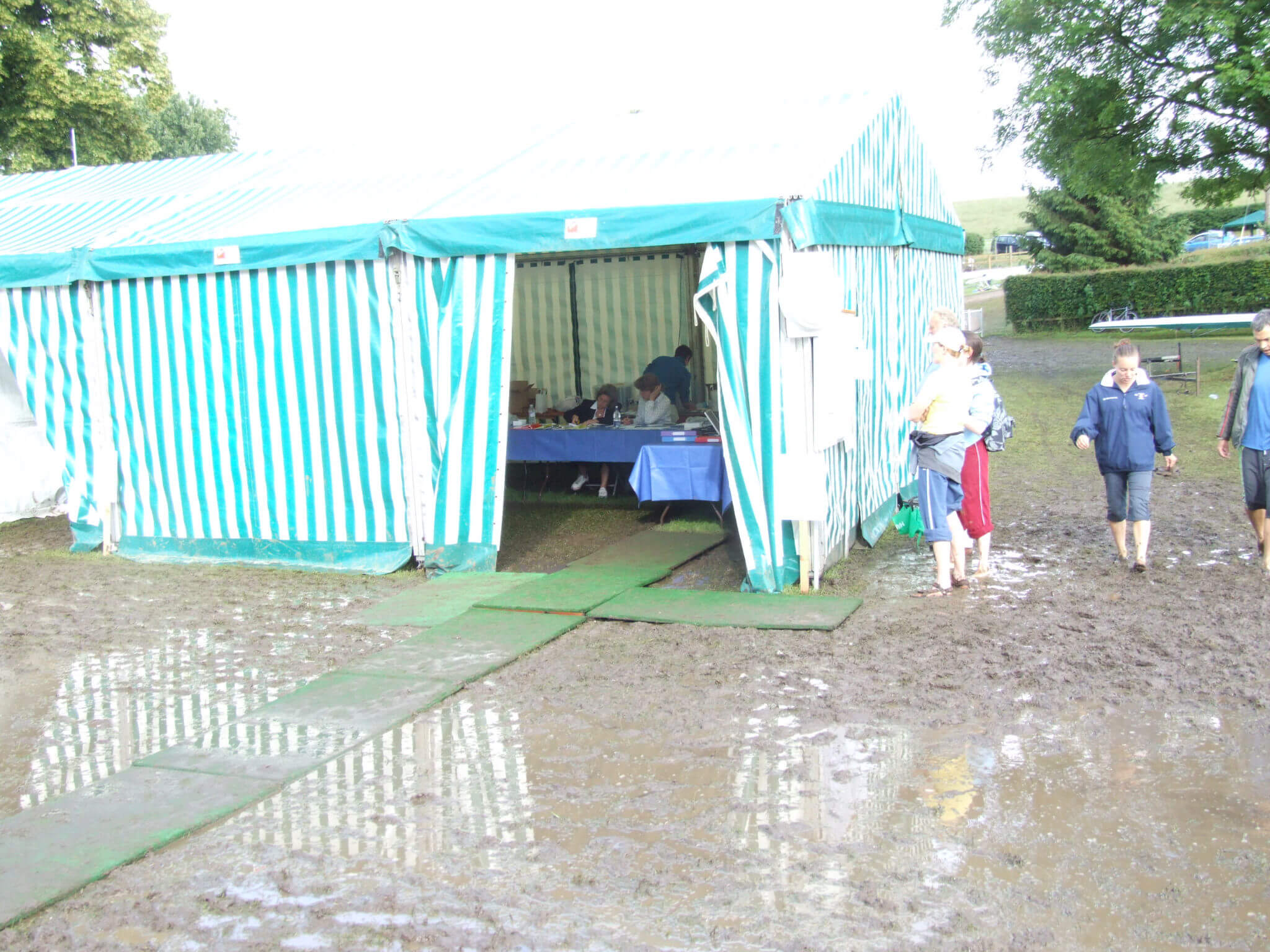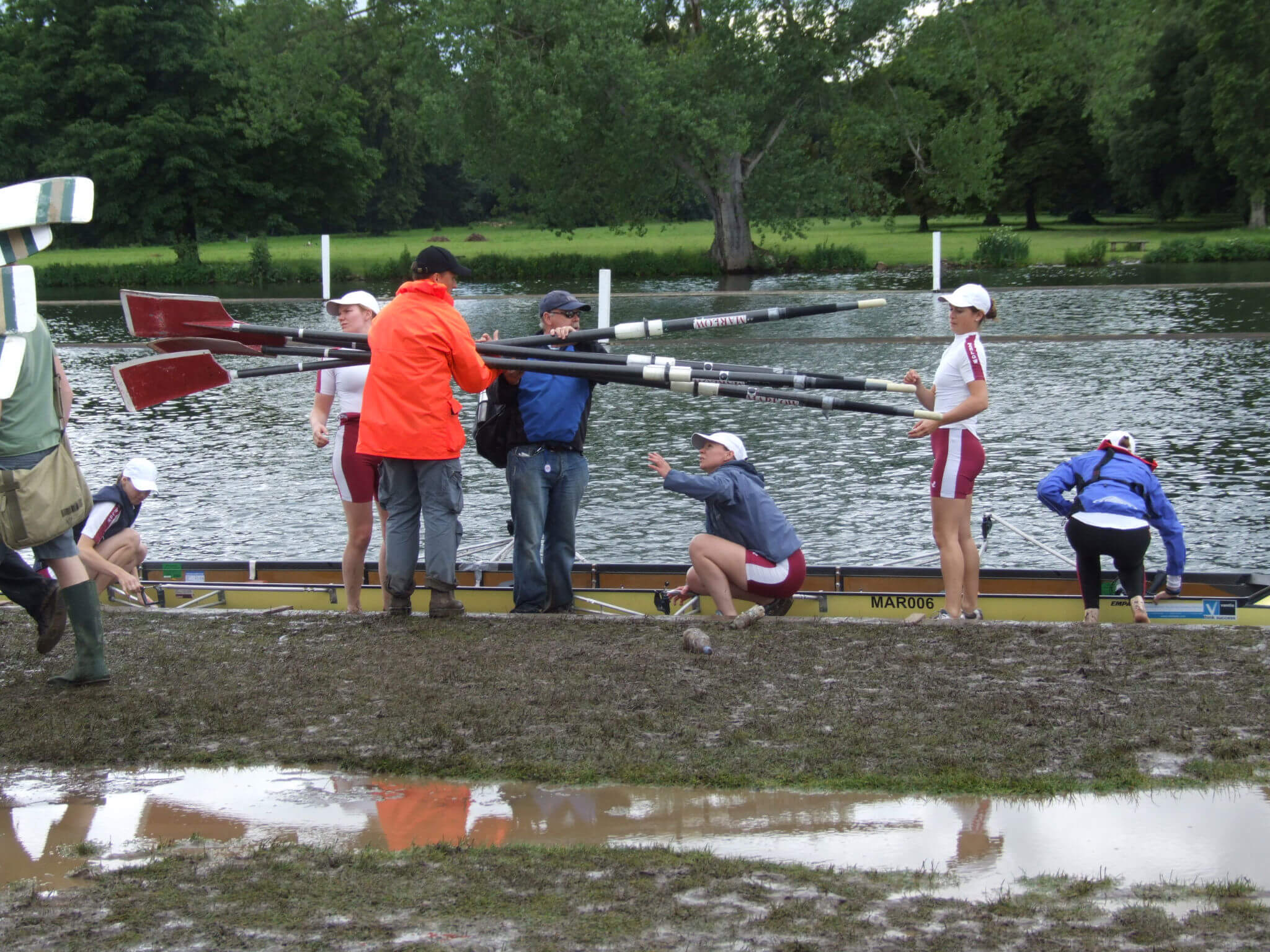About HWR
Our History

Why Henley Women's Regatta was started in 1988
During the early 1960s, the number of serious oarswomen in England probably numbered fewer than 1,000. Now, according to British Rowing statistics, women now account for more than 46% of the country’s registered rowers.
As the number of women rowers continued to increase during the 1980s, so did the standard of competition. However, while Henley Royal Regatta provided a focus for men’s crews around the end of the academic term, women didn’t have an equivalent target; there were no women’s events in the HRR programme at the time.
During discussions at the National Championships in 1987 Women’s National Coach Rosie Mayglothling (who, as Rosie Clugston, had won the Invitation Double Sculls at Henley Royal Regatta in 1982 with Astrid Ayling) therefore suggested that the women should organise their own regatta on the Henley reach, preferably on a day shortly before the Henley Royal Regatta, so that college crews would be able to take part.
The enthusiasm and support for a women’s regatta built at the World Championships in Copenhagen later that year and at subsequent meetings. An essential pre-requisite was the approval of Stewards of Henley Royal Regatta. Whilst they do not own the water, they do own most of the land each side of the course, as well as all the installations, so their support was vital. Rosie and Christine Aistrop (the first chairman of the proposed event), were delighted when their persistence paid off and permission was given for a women’s regatta to be held on the Royal Regatta course in June 1988.
A change of course: The first Henley Women's Regatta
It was made clear from the outset that Henley Women’s Regatta could not use HRR’s enclosures or boat tents due to construction work. Christine then approached Tom Copas and his family, the owner of Remenham Farm, who were immediately keen to support the regatta, offering the venue, and their family’s assistance in establishing Henley Women’s Regatta.
In order to make Remenham Farm the focal point of the regatta, the HWR committee decided to reverse the direction of the course. The inaugural regatta was to be rowed over 2,000m from the Henley Royal finish down to the upstream end of Temple Island. Once this decision was made, the Stewards allowed HWR the use of certain facilities at the regatta finish, including the floating grandstand, for aligning and starting purposes, and a raft for the boating area.
The committee had little idea of what the response from spectators, sponsors, and the sporting world might be. As well as the National Squad, it was hoped that that regatta would attract good college and club crews and, if any sponsorship was to be obtained, some overseas entries were desirable. Unfortunately, the non-British competition was limited to some Irish crews and one Dutch sculler, but the entry in College VIlls and Senior II IVs was such that the events had to be subdivided into two and three sections, respectively.
There were 109 entries requiring 97 races from 9.00am to 6.50pm. Disappointingly (possibly the result of the excessive doubling-up), there was a large number of scratchings, which left University College, Dublin with no competition in the University VIlls. As this seemed shabby treatment, the National Squad agreed to race UCD at the end of the programme.
Although there were aspects that could be improved, such as the length of the course and whether to allow doubling-up, in principle it was clear that the first Henley Women’s Regatta fulfilled a long desired need, and the committee felt able to contemplate a second regatta.

The early years: Additions, improvements, successes
In 1989, the number of events was increased with the addition of three more for lightweights, and other events were replaced; Club eights for University eights was a popular change. The Open events still tended to attract small entries, as they were expected to be dominated by the National Squad, but there was some excellent racing, particularly in the final of the Open Eights between Thames and the visiting College champions from the USA – Radcliffe. The latter also won the Open Coxed Fours.
There were 137 entries and 114 races. The regatta was improved as a spectacle by the reduction of the course length to approximately 1,500m, so that the spectators at Remenham Farm could see the finish.
The formula was much the same for 1990. The junior events had not, to this point, been well supported and these were confined to the coxless fours, which attracted only four entries. In contrast, the entries for College eights, Senior I and II coxed fours and Open and Lightweight Sculls, were so large that they all had to be subdivided; the Senior II Coxed Fours into four groups, giving a total of 198 entries in 29 events. The net result was 169 races, from 8.00am to 7.12pm at four minute intervals.
There was some dissatisfaction over the subdivision of events. The college crews in particular wished to have an overall winner at the end of proceedings. The committee accepted this as a legitimate aspiration, but to do so would require more races and the timetable was already posing problems. Races at four minute intervals gave no leeway for anything to go wrong and, if the entry continued to increase, the racing could not be successfully completed in one day.
In 1991, partly from the committee’s decisions and partly from outside agencies, changes arose. As a result of the tight timetable in 1990, the area between the Regatta Finish and Henley Bridge had become very congested at times with crews waiting to race. The National Rivers Authority (NRA, now the Environment Agency) considered this to be a potential safety hazard, as well as causing inconvenience to other river users, and authorisation was only given for the 1991 HWR on condition that, like the Royal Regatta, it was raced upstream.
This requirement made it essential for the HWR committee to consider the question that had been asked more than once: What sort of regatta did they have in mind? It had never been aimed at the novice or less experienced oarswoman, but at the top 50% of the female rowing population. The change of direction could lead to quite severe conditions in inclement weather; therefore, the committee removed the last remaining Junior event. All other events were classified as Invitation, Open, or Lightweight, and no events were subdivided.
The Committee now had some re-thinking and planning to do, to ensure the regatta could continue to grow and develop, without becoming the victim of its own success. After the increased entry in 1989, the Chairman, Margaret Adams, had sounded out the HRR Committee of Management on the possibility of HWR becoming a two-day regatta. This plan had been rejected on the basis that men’s crews racing at Marlow traditionally rowed up to Henley on the Sunday, and this schedule would be compromised. The approach was revisited after the 1990 regatta and, although the proposal for racing on the Sunday was again refused, permission was given for qualifying races to be held beforehand, to bring events with large entries down to manageable proportions. Races in the form of time trials (the same format as HRR) duly took place on the Friday evening in four events; Club and College Eights and Coxed Fours. Even after this pruning of the entries, the Saturday programme still consisted of 121 races at five minute intervals.
The crews appeared to be satisfied with the changes; possibly because the regatta was adopting yet more of the Royal Regatta procedures, and their wish to have a clear-cut winner in each event had now been achieved. The strong head wind that prevailed for most of the day underlined the point that the Henley course demands a certain level of competence, and that the decision to remove all Junior or lower category events had been correct.
For the 1992 regatta, negotiations continued with the Stewards and the NRA for racing on Sunday over 2,000 metres. To the great delight of HWR, the Committee of Management relented and gave permission for racing on Sunday afternoon. This change would allow the men’s crews to row up from Marlow to Henley and the morning service to take place at Remenham Church, without interference by or with HWR. Permission was also initially given for racing over 2,000m, which was then announced in the early publicity for the event. The organisers were engaged in working out how to mark the finish without encroaching upon the area of the HRR Public Enclosure, when they received the unwelcome news of a change of heart by the NRA. The NRA had decided that if the course were extended to 2,000m, all crews would have to continue to the end of the Royal Regatta course and return to the start via the navigation channel, which would revive the congestion in the area between the Regatta Finish and Henley Bridge. Therefore, for safety reasons, HWR must be limited to the same course as in 1991.
Although disappointed, the committee pressed on with arrangements. The Invitation Eights and Fours were dropped in favour of Open Coxless Fours, but the events were otherwise the same as in 1991. A worrying fact was the very low entry from the Oxford colleges whose only representative was Somerville, and no qualifying racing was necessary on Friday evening. Nonetheless, 163 entries were received, compared with 166 in 1991, and the programme offered 110 races on Saturday at five minute intervals. The semi-finals and finals (40 races) were held on Sunday between 1.30pm and 5.00pm. Overseas clubs included Alfred R.C. from South Africa in Club eights; Dartmouth College, U.S.A., who were impressive winners of College eights; and Ridley College, Canada, who lost an exciting final in the College coxed fours to Oxford Polytechnic (now Oxford Brookes University). Saturday’s programme started unfavourably. On arrival to start racing at 9.00 am, it was discovered that overnight a launch had managed to foul the cables anchoring one of the stakeboats and ripped them all out, so they had to be repositioned. The start of racing was delayed until 10.30am and the first few races had to free start from the bank. But with the willing co-operation of crews and officials, the programme was back on schedule by lunchtime. The weather was co-operative and it certainly seemed that the first two-day regatta was most successful. Many spectators came on Sunday and, to judge from subscriptions received after the regatta, were duly impressed. Since then, racing has continued on Sunday, and now starts around 9.00am on that day with heats, semi-finals, and finals.

HWR in the 2000s: A tradition grows
The 10th Anniversary of HWR was celebrated in 1997. The regatta grew considerably over the following years, with the entry in 2003 exceeding that in the preceding two years. Heats were now held on Friday afternoon for heavily subscribed events. To encourage overseas entry, a reception for international crews was held at the River and Rowing Museum, sponsored from 1997 to 2002 by PricewaterhouseCoopers and in 2003 and 2004 by Invesco Perpetual.
In 2004, a new structure of events was introduced, to reflect the changes in women’s rowing. Club and College events were combined, and the new names of Intermediate and Senior were introduced in response to a request from the Competition Review Group. The 2004 regatta also benefited from a generous sponsorship from Invesco Perpetual, an investment management firm located in Henley, which allowed more facilities to be introduced for the competitors and a grandstand for viewing.
An early summer of seeming unending rain in 2007 meant the waterlogged site quickly turned into a quagmire.







Extreme wind conditions caused the cancellation of part of the National Schools’ Regatta in 2008. A special regatta at Eton was quickly organised to offer some of the events for boys that had been cancelled, but the girls’ events were not catered for. HWR responded by hosting special events for J16 girls singles and J16 girls eights. As a result, in 2009 the Committee offered trial events in J16 girls quads and coxed fours. The entry was such that time trials were required for these events. Both were made full events, with trophies offered in the 2010 regatta. Also in 2009, the Intermediate events were split into Club and University again, as a result of comments received from clubs and competitors. The regatta was very pleased to receive a trophy for the University Fours from the Cruickshank family, in memory of Cathy Cruickshank, who died in 2006. Cathy had been the regatta secretary for several years. The 2009 regatta hosted a special fundraising event, organised by Sarah Winckless, who after a hugely successful international career came out of retirement to race at the regatta for the first time, raising more than £30,000 for Huntington’s Disease research.
In 2010, British Rowing revised the classification and points system for competition, and for the 2011 regatta the committee responded by revising the qualification rules for each event. Senior lightweight double sculls were introduced to help improve the development pathway of lightweight sculling.
The 25th Henley Women's Regatta
In 2012, the winter and spring had been unusually dry, but from April onwards the weather was wet and cold. By the beginning of June it was clear that the ground was so waterlogged that the site could not take on the new look the Committee had hoped for the 25th Regatta, and a repeat of the damage to Copas Partnership’s land that occurred in 2007 was out of the question.
The first casualty was the grandstand (which was too heavy for the sodden land), and the relocation of the boat racks to the car park soon followed. By the start of the regatta, half of the site was underwater, and the river ‘red boarded’.
The regatta was at risk of cancellation. In the week prior to the regatta, several committee members, and in particular Fiona and Richard Dennis, Julie Watson, and Phil Clements, together with Chairman Diane Graham, worked through several nights to salvage the regatta, re-timetabling several times to ensure the staging of the regatta.
Enlarged time trials were introduced for the Friday, with races taking several minutes longer than usual as competitors battled into the strong stream and gale force winds. By Sunday, semifinals and finals were held in slightly easier conditions. Racing on Sunday was surprisingly close, given the way in which the stream affected both stations in different parts of the course.
In 2013 Olympic medallist Miriam Luke took over the role of Chairman of the Regatta from Diane Graham, who stepped down after 15 years in the position. The lightweight coxless fours event was withdrawn and the lightweight coxless pairs reintroduced. That year also saw live streaming of the regatta for the first time.

2017: The 30th regatta
The regatta continued to grow, with more and more crews wanting to compete on this famous course. And with an ever-increasing rise in standard, winning at Henley Women’s Regatta became an ever more significvant achievement.
Live streaming in 2017 incorporated the use of a drone to follow some races. The senior fours event became coxless for the first time, and a new requirement was introduced that events would only run if four or more entries have been received when entries close.
Creating a pathway for progression
For 2018, the committee launched a revised programme of events, driven by a desire to elevate the standard of competition, particularly in the Championship category, and to provide a clearer pathway for progression in women’s rowing.
The total number of events was reduced from 29 to 26. For seniors, these were classified as in Championship and Aspirational with a single Development event. Junior and Para-rowing events were retained.
Like many sporting competitions, Henley Women’s Regatta did not run in 2020 due to the Covid-19 pandemic, and in 2021 took place in early July, in the ‘slot’ usually occupied by Henley Royal Regatta, which was in August that year. This meant that the HRR stakeboats were not in position for HWR, so racing was over a slightly shorter course starting from stakeboats near the top of Temple Island.
For the four years from 2022 to 2025, the regatta has attracted over 500 entries.
Paralympic Champion Naomi Riches became chairman for two years in 2022 and 2023 before stepping down. She was succeeded by Naomi Ashcroft, whose committment to the regatta is demonstrated by her long racing career at HWR from the early years right up to 2019.
Acknowledgements
The HWR Committee wishes to express its profound and grateful thanks to the Stewards of Henley Royal Regatta and in particular to the late Chairman of the Committee of Management, Peter Coni OBE, QC past Chairman Mike Sweeney and his successor Chairman, Sir Steve Redgrave. The active help of Tom Copas has also been equally vital to the success of the event. A generous donation was received from the Sports Council (now Sport England) to enable the inaugural regatta to take place, whilst a stalwart body of subscribers has made a significant contribution each year. HWR profusely thanks the individuals and companies who sponsor HWR. Lastly, the Regatta thanks all those people whose hard work during the event and throughout the year has established a prominent place for Henley Women’s Regatta in the domestic and international rowing calendars.


